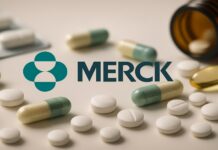Mallinckrodt plc a leading global specialty biopharmaceutical company announced the results from three Mallinckrodt-sponsored retrospective analyses providing health economic insights for the use of H.P.
Acthar Gel (repository corticotropin injection; RCI) in three distinct patient populations: acute relapses of multiple sclerosis (MS), systemic lupus erythematosus (SLE) and sarcoidosis. The results of each study were presented in poster sessions at the Academy of Managed Care Pharmacy’s (AMCP) 2016 Managed Care & Specialty Pharmacy Annual Meeting, Apr. 19-22, in San Francisco.
Acute Relapses of MS Retrospective Analysis
“Efficacy and safety of treatments for acute relapses of multiple sclerosis: results of a systematic literature review” (Njue A, Damal K, Lyall M, Costello J, Heyes A, Philbin M. ABSTRACT G23, page 72.) systematically evaluated 43 published studies of clinical evidence from randomized and nonrandomized trials of Acthar and relevant comparators used in the treatment of MS relapses.
Findings associated with the use of Acthar as an option in patients who remain symptomatic after initial treatment include:
- For relapses that are severe or disabling enough to require treatment, Acthar, high-dose intravenous methylprednisolone (IVMP), high-dose oral prednisone and plasmapheresis (PMP) were shown to be effective; intravenous immunoglobulin (IVIg) was not.
- Acthar is a treatment option associated with decreased resource use and similar cost compared with PMP in patients who remain symptomatic despite initial treatment with IVMP.1
o In patients with two-year follow-up, Acthar recipients had fewer hospitalizations (0.5 vs. 1.0, p<0.0001) and fewer outpatient visits (56 vs. 87, p<0.0001) compared
with those treated with PMP or IVIg.
o Patients treated with Acthar had lower total costs at two years ($175,000) compared with those treated with PMP or IVIg ($208,000 [p=0.06]).
Limitations of the Study
There was heterogeneity across studies in terms of patient populations, definition of efficacy outcomes and assessment time points as well as limited reporting of safety outcomes. In addition, there were only two studies which evaluated Acthar, and half of the included randomized controlled trials had small sample sizes (13 of 23 trials included 17 to 35 patients).
About MS
MS is neurologic disorder that affects the nerves of the brain and spinal cord.2 Symptoms can include fatigue, balance/coordination issues, numbness or tingling, vision problems, muscle spasms, tremors and emotional changes.2 More than eight in 10 people with MS will experience a relapse, or flare-up, that brings new or worsening symptoms.3
SLE Retrospective Analysis
“Real-world treatment patterns and demographic, clinical and economic characteristics of systemic lupus erythematosus patients initiating repository corticotropin injection therapy” (Wu B, Deshpande G, Tunceli O, Gu T, Popelar B, Philbin M, Damal K, Schepman P, Wan GJ. ABSTRACT M17, page 109.) described the clinical and health economic profile of SLE patients initiating Acthar in a commercially insured U.S. population using claims data from the HealthCore Integrated Research Database4 between Jan. 1, 2006 and Mar. 31, 2015. Among 29,401 SLE patients identified, 29 (0.1%) initiated Acthar, on average, at 23 months after diagnosis and were followed for an average of 24 months. The average age at diagnosis was 45.1 years and 89.7% of the patients were female. The analysis identified medical costs specific to SLE-related symptoms as well as from all causes.
Findings associated with the use of Acthar in this population of SLE patients included:
- A medical cost offset was observed due to reduced hospitalization costs, despite an increase in all-cause or SLE-related pharmacy costs after initiation of Acthar, which offset the drug costs by 32%-37%.
- After Acthar initiation, patients incurred significantly lower per patient per month (PPPM) medical costs specific to SLE ($3,011 vs. $893, p=0.02) compared with pre-initiation period, mainly driven by lower PPPM costs for SLE-related hospitalization ($2,444 vs. $434, p=0.02).
- Further, where those same SLE patients incurred medical costs related to all causes including SLE, there was a 20.2% reduction in the rate of hospitalizations (238 vs. 190 patients per 1,000 patient year, p=0.40), and a 12.6% reduction in the rate of all-causes emergency department visits (238 vs. 208 patients per 1,000 patient year, p=0.59) during the Acthar post-initiation period as compared to the pre-initiation period. These results were not statistically significant, perhaps due to small sample size.
Limitations of the Study
This study estimated costs from a commercial payer’s perspective, which may underestimate the overall cost burden of the disease, and may have limited generalizability to a non-commercially insured population. Additionally, this study found trends of decreased healthcare resource utilization after Acthar initiation, but most, with the exception of hospitalizations, were not statistically significant due to small sample size.
About SLE
SLE is an autoimmune disease in which the immune system produces antibodies to cells within the body leading to widespread inflammation and tissue damage.5 It is the most common form of lupus, a condition that impacts at least 1.5 million Americans.6 Ninety percent of those diagnosed with lupus are women, often between the ages of 15-44.6 Lupus is characterized by periods of illness “flares” and remissions and the disease can affect the joints, skin, brain, lungs, kidneys, and blood vessels.5 Symptoms may include fatigue, pain or swelling in joints, skin rashes, and fevers.5
Sarcoidosis Retrospective Analysis
“Patterns and predictors of repository corticotropin injection therapy use in patients with sarcoidosis,” (Knight T, Philbin M, Bond C, Popelar B, Wang L, Niewoehner J, Anastassopoulos KP, Wan GJ. ABSTRACT D06, page 44.) described the profile of 58 sarcoidosis patients receiving Acthar and identified predictors of prescribed use based on demographic, pre-treatment medications and resource use, and comorbid conditions. These patients were compared with patients receiving TNF-α inhibitors and/or rituximab (n=2468). Acthar patients were identified from a total of 170,913 individuals diagnosed with sarcoidosis from three U.S. commercial health insurance claims databases from Jul.1, 2009 to Jun. 30, 2014.The average age of Acthar patients was 50.4 years and the majority were female (67.2%). Those in the Acthar group had more severe disease vs. the comparator group as indicated by higher comorbidity and chronic disease scores. The baseline characteristics between the two groups were not statistically significant.
Findings on the profile of sarcoidosis patients receiving Acthar in a real-world setting included:
- Prior prednisone use (OR=2.0; 95% CI=1.04, 3.85) and increasing Chronic Disease Score (OR=1.1; 95% CI=1.00, 1.19), were predictive of future Acthar treatment.
- Most patients initiating Acthar had previously been treated with prednisone (74.1%). Previous use of immunosuppressive as well as anti-malarial treatments were common.
- Acthar is used to treat sarcoidosis patients, though not commonly (a small fraction of those patients identified in this analysis).
Limitations of the Study
This study was limited to comparators of TNF-α inhibitors and rituximab. While the comparators chosen are likely to be given consideration when choosing Acthar, other common sarcoidosis treatments such as corticosteroids, cytotoxic agents, and anti-malarial agents might be considered as comparators for future research.
About Sarcoidosis
Sarcoidosis is a disease of varying severity7 that leads to inflammation, usually in the lungs, skin or lymph nodes when cells group together into clumps called granulomas.8 The lungs are affected in more than 90% of sarcoidosis cases,9 but the number of organs impacted is likely to increase over time.10 Sarcoidosis occurs mostly in people ages 20 to 50, African Americans, especially women, and people of Northern European origin. It is estimated that there are 1 to 40 cases per 100,000 people in the U.S.11
About H.P. Acthar Gel (repository corticotropin injection)
H.P. Acthar Gel (repository corticotropin injection), is an injectable drug approved by the U.S. Food and Drug Administration (FDA) for the treatment of 19 indications. Of these 19 indications, the product currently generates substantially all of its net sales from the following on-label indications:
- Inducing a diuresis or a remission of proteinuria in nephrotic syndrome without uremia of the idiopathic type or that due to lupus erythematosus.
- Treatment of acute exacerbations of multiple sclerosis in adults. Controlled clinical trials have shown Acthar to be effective in speeding the resolution of acute exacerbations of multiple sclerosis. However, there is no evidence that it affects the ultimate outcome or natural history of the disease.
- As monotherapy for the treatment of infantile spasms (“IS”) in infants and children under 2 years of age.
- Use during an exacerbation or as maintenance therapy in selected cases of systemic lupus erythematosus.
- Use during an exacerbation or as maintenance therapy in selected cases of systemic dermatomyositis (polymyositis).
The company is also exploring the possibility of developing other approved indications and the possibility of pursuing FDA approval of additional indications currently unapproved in the Acthar label where there is high unmet medical need. For more information about Acthar, please visit www.acthar.com. Full prescribing information may be accessed here.
ABOUT MALLINCKRODT
Mallinckrodt is a global business that develops, manufactures, markets and distributes specialty pharmaceutical and biopharmaceutical products and therapies, as well as nuclear imaging products. Areas of focus include autoimmune and rare diseases in specialty areas like neurology, rheumatology, nephrology and pulmonology; immunotherapy and neonatal respiratory critical care therapies; analgesics and hemostasis products; and central nervous system drugs. The company’s core strengths include the acquisition and management of highly regulated raw materials and specialized chemistry, formulation and manufacturing capabilities. The company’s Specialty Brands segment includes branded medicines; its Specialty Generics segment includes specialty generic drugs, active pharmaceutical ingredients and external manufacturing; and the Nuclear Imaging segment includes nuclear imaging agents. To learn more about Mallinckrodt, visit www.mallinckrodt.com.
CONTACTS
Media
Rhonda SciarraSenior Communications Manager
314-654-8618
rhonda.sciarra@mallinckrodt.com Meredith Fischer
Senior Vice President, Communications and Public Affairs
314-654-3318
meredith.fischer@mallinckrodt.com
Investor Relations
Coleman N. Lannum, CFASenior Vice President, Investor Strategy and IRO
314-654-6649
meredith.fischer@mallinckrodt.com
1 Hansen RN, Gold LS, Schepman P, Niewoehner J, Philbin M, Damal K. Health care resource use and costs of adrenocorticotropic hormone in relapses of multiple sclerosis. Presented as an Encore Presentation – AMCP Nexus; October 26-28, 2015. Orlando, FL.
2 Multiple Sclerosis Foundation. Symptoms of Multiple Sclerosis. Accessed April 19, 2016 at http://msfocus.org/Symptoms-of-Multiple-Sclerosis.aspx
3 National Multiple Sclerosis Society. Relapsing-remitting MS (RRMS). Accessed April 19, 2016 at http://www.nationalmssociety.org/What-is-MS/Types-of-MS/Relapsing-remitting-MS
4 Information on the HealthCore Integrate Research Database available at: https://www.healthcore.com/database/.
5 Systemic lupus erythematosus (SLE or lupus), The Centers for Disease Control and Prevention, Available at: http://www.cdc.gov/arthritis/basics/lupus.htm.
Accessed April 19, 2016.
6 Lupus Foundation of America. What is lupus? Available at: http://www.lupus.org/answers/entry/what-is-lupus. Accessed April 19, 2016.
7 Judson MA. The clinical features of sarcoidosis: a comprehensive review. Clin Rev Allerg Immunol. 2015;49:63-78.
8 National Library of Medicine. Sarcoidosis. Available at: https://www.nlm.nih.gov/medlineplus/sarcoidosis.html. Accessed April 19, 2016.
9 Baughman RP, Culver DA, Judson MA. A concise review of pulmonary sarcoidosis. Am J Respir Crit Care Med. 2011;183:573-581.
10 Judson MA, Boan AD, Lackland DT. The clinical course of sarcoidosis: presentation, diagnosis, and treatment in a
large white and black cohort in the United States. Sarcoidosis Vasc Diffuse Lung Dis. 2012;29:119-127.
11 Erndal BS, Clymer BD, Yildiz VO, Julian MW, Crouser, ED. Unexpectedly high prevalence of sarcoidosis in a representative U.S. Metropolitan population. Respir Med. 2012 Jun;106(6):893-9.




















